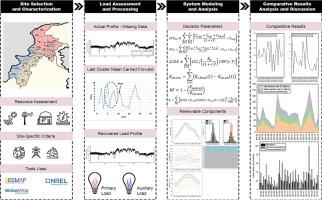Optimal planning and operation of heterogeneous autonomous and grid-connected microgrids based on multi-criteria techno-economic, environmental, and social indices
IF 9.9
1区 工程技术
Q1 ENERGY & FUELS
引用次数: 0
Abstract
Sustainable energy transition involves the execution of recent technologies as a means of ensuring energy access and security. However, the increasing adoption of such technologies, particularly in the presence of diverse constraints, poses significant challenges from a planning perspective. In this context, the multi-objective analysis offers valuable insights for decision-making that balances mutual benefits, as relying solely on a single objective may increase the risk level for stakeholders engaged in coordinated decisions. Based on the real dataset, this study presents a comparative multi-criteria techno-economic, environmental, and social evaluation of site-specific unified standalone and grid-connected hybrid microgrids. The study employs a modified Last Cluster Mean Carried Forward approach for data processing, incorporating the Proprietary Derivative-free Algorithm and Original Grid-Search Algorithm to ensure a standardized comparison. Results reveal the substantial advantages of grid-connected systems over standalone counterparts, with reductions of 12.54 % to 63.73 % and 68.93 % to 89.13 % in terms of Net Present Cost and Levelized Cost of Energy, respectively. Grid-connected systems exhibit superior adaptability, recovering 52.3 % to 98.1 % surplus energy with a Renewable Fraction averaging 77.1 % to 87.9 %. However, these systems were hindered by frequent interruptions and required a minimum capacity shortage of 2.5 % to 3.5 %. Furthermore, grid-connected systems have proved feasible when carbon emissions, forests required to absorb the emissions, and the Social Cost of Carbon Emissions are considered in the range of 4.65–67.13 kiloton (metric), 423.32–6108.53 ha, and $0.24-$3.42 million, respectively. Social analysis and sensitivity analyses are performed to justify the robustness and adaptability. Lastly, the findings are followed by policy recommendations and results validation by comparing prevailing government tariffs and other studies.

基于多标准技术经济、环境和社会指数的异构自主并网微电网的优化规划与运行
可持续能源转型涉及采用最新技术作为确保能源获取和安全的手段。然而,越来越多地采用这些技术,特别是在存在各种制约因素的情况下,从规划的角度来看构成了重大挑战。在这种情况下,多目标分析为平衡互惠互利的决策提供了宝贵的见解,因为仅仅依靠单一目标可能会增加参与协调决策的利益相关者的风险水平。本研究基于真实数据集,对特定地点的统一独立微电网和并网混合微电网进行了技术经济、环境和社会多标准比较评估。研究采用修改后的 "最后簇均值前移 "方法进行数据处理,并结合 "专有无衍生算法 "和 "原始网格搜索算法",以确保比较的标准化。结果显示,与独立系统相比,并网系统具有很大优势,净现值成本和平准化能源成本分别降低了 12.54% 至 63.73%,以及 68.93% 至 89.13%。并网系统的适应性更强,可回收 52.3 % 至 98.1 % 的剩余能源,可再生能源比例平均为 77.1 % 至 87.9 %。然而,这些系统受到频繁中断的阻碍,需要至少 2.5 % 至 3.5 % 的容量短缺。此外,在考虑碳排放量、吸收排放量所需的森林和碳排放的社会成本时,证明并网系统是可行的,其范围分别为 4.65-67.13 千吨(公吨)、423.32-6108.53 公顷和 24 万美元-342 万美元。进行了社会分析和敏感性分析,以证明其稳健性和适应性。最后,对研究结果提出了政策建议,并通过比较现行政府关税和其他研究对结果进行了验证。
本文章由计算机程序翻译,如有差异,请以英文原文为准。
求助全文
约1分钟内获得全文
求助全文
来源期刊

Energy Conversion and Management
工程技术-力学
CiteScore
19.00
自引率
11.50%
发文量
1304
审稿时长
17 days
期刊介绍:
The journal Energy Conversion and Management provides a forum for publishing original contributions and comprehensive technical review articles of interdisciplinary and original research on all important energy topics.
The topics considered include energy generation, utilization, conversion, storage, transmission, conservation, management and sustainability. These topics typically involve various types of energy such as mechanical, thermal, nuclear, chemical, electromagnetic, magnetic and electric. These energy types cover all known energy resources, including renewable resources (e.g., solar, bio, hydro, wind, geothermal and ocean energy), fossil fuels and nuclear resources.
 求助内容:
求助内容: 应助结果提醒方式:
应助结果提醒方式:


